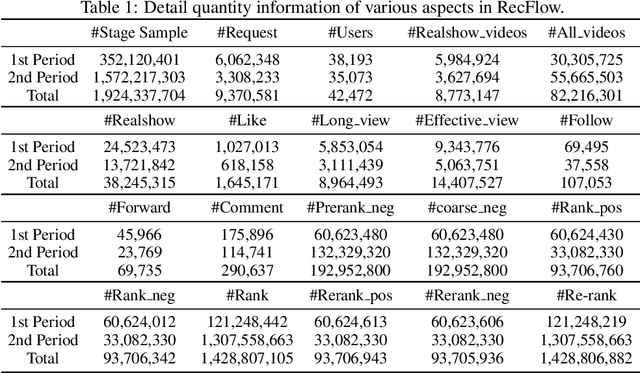Wuchao Li
RecFlow: An Industrial Full Flow Recommendation Dataset
Oct 28, 2024



Abstract:Industrial recommendation systems (RS) rely on the multi-stage pipeline to balance effectiveness and efficiency when delivering items from a vast corpus to users. Existing RS benchmark datasets primarily focus on the exposure space, where novel RS algorithms are trained and evaluated. However, when these algorithms transition to real world industrial RS, they face a critical challenge of handling unexposed items which are a significantly larger space than the exposed one. This discrepancy profoundly impacts their practical performance. Additionally, these algorithms often overlook the intricate interplay between multiple RS stages, resulting in suboptimal overall system performance. To address this issue, we introduce RecFlow, an industrial full flow recommendation dataset designed to bridge the gap between offline RS benchmarks and the real online environment. Unlike existing datasets, RecFlow includes samples not only from the exposure space but also unexposed items filtered at each stage of the RS funnel. Our dataset comprises 38M interactions from 42K users across nearly 9M items with additional 1.9B stage samples collected from 9.3M online requests over 37 days and spanning 6 stages. Leveraging the RecFlow dataset, we conduct courageous exploration experiments, showcasing its potential in designing new algorithms to enhance effectiveness by incorporating stage-specific samples. Some of these algorithms have already been deployed online, consistently yielding significant gains. We propose RecFlow as the first comprehensive benchmark dataset for the RS community, supporting research on designing algorithms at any stage, study of selection bias, debiased algorithms, multi-stage consistency and optimality, multi-task recommendation, and user behavior modeling. The RecFlow dataset, along with the corresponding source code, is available at https://github.com/RecFlow-ICLR/RecFlow.
DimeRec: A Unified Framework for Enhanced Sequential Recommendation via Generative Diffusion Models
Aug 22, 2024Abstract:Sequential Recommendation (SR) plays a pivotal role in recommender systems by tailoring recommendations to user preferences based on their non-stationary historical interactions. Achieving high-quality performance in SR requires attention to both item representation and diversity. However, designing an SR method that simultaneously optimizes these merits remains a long-standing challenge. In this study, we address this issue by integrating recent generative Diffusion Models (DM) into SR. DM has demonstrated utility in representation learning and diverse image generation. Nevertheless, a straightforward combination of SR and DM leads to sub-optimal performance due to discrepancies in learning objectives (recommendation vs. noise reconstruction) and the respective learning spaces (non-stationary vs. stationary). To overcome this, we propose a novel framework called DimeRec (\textbf{Di}ffusion with \textbf{m}ulti-interest \textbf{e}nhanced \textbf{Rec}ommender). DimeRec synergistically combines a guidance extraction module (GEM) and a generative diffusion aggregation module (DAM). The GEM extracts crucial stationary guidance signals from the user's non-stationary interaction history, while the DAM employs a generative diffusion process conditioned on GEM's outputs to reconstruct and generate consistent recommendations. Our numerical experiments demonstrate that DimeRec significantly outperforms established baseline methods across three publicly available datasets. Furthermore, we have successfully deployed DimeRec on a large-scale short video recommendation platform, serving hundreds of millions of users. Live A/B testing confirms that our method improves both users' time spent and result diversification.
 Add to Chrome
Add to Chrome Add to Firefox
Add to Firefox Add to Edge
Add to Edge